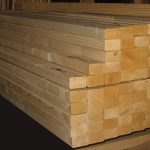We may receive a commission when you use our affiliate links. However, this does not impact our recommendations.

Steam-bending wood is awesome, but I’ve never been a big fan of having a potential bomb in my house (or in the office). So I’ve worked at mastering cold-lamination bending, but I’ve found there’s a lot of prep work (resawing, drum sanding, etc.), and the plastic resin glue is nasty stuff. It’s the only glue that has ever gashed my arm.
So yesterday I pleased to see a big box propped up against my front door. Inside is a chunk of ash Compwood that I purchased from FlutedBeams.com. Compwood sounds like magical stuff , you can bend it cold, put it in your form and it retains any shape when it dries down to 6 or 7 percent moisture content.
There is no steam box. No plastic resin. Just cut the stuff and bend it.
How does it work? It is kind of like a flexible drinking straw. The wood is heated then compressed along its length , so it’s about 80 percent of its original length. This compresses the wood fibers like an accordion. As long as the wood is a little wet (20 to 25 percent MC), you can bend it in any plane. When it gets down to 12 to 14 percent MC, you can take it out of the form. When it reaches equilibrium, you can work it just like normal wood , rout it, plane it, glue it, sand it.
If you want technical details, including a manual on how to use the stuff for cabinetmaking, visit the official Compwood Products web site.
I’m going to be building a couple more Windsor chairs this summer, so I’m going to give the Compwood stuff a test run for the arms and the bows of the chairs. And I’ll definitely post some video of the process.
– Christopher Schwarz
Other Wood Bending Resources to Investigate
– “The Complete Manual of Wood Bending” (Linden) Lon Schleining. It’s a good introduction to the concepts of wood bending that I read years ago.
– The Ultimate Steam Box from The Windsor Institute. This is a nice system that we used to bend components during a chair class.
– February 2004 issue of Popular Woodworking. I wrote an article on cold laminations that I used to make an Eames coffee table.
– October 2005 issue of Popular Woodworking. Robert Lang demonstrates how to use cold bending to make contemporary shelves.
Here are some supplies and tools we find essential in our everyday work around the shop. We may receive a commission from sales referred by our links; however, we have carefully selected these products for their usefulness and quality.









I want to know what kind of structural properties this product has after it is dried out. How strong is it compared to regular wood? Does it get wiggly again on a humid day? Bows for a windsor chair sound pretty safe because it will be fully supported, but what happens when it is used on its own to make interesting curved shapes?
Let me clarify for a moment: I know that the steam box isn’t under pressure (if made correctly). When I refer to the "bomb" in my entry, I am referring to the compressed gas used to heat the water. That’s the bomb.
I never had much luck with a teakettle approach for large pieces.
Also, I know you can use fire and a pipe as well. But I don’t have a fire pit in my shop (sadly).
Bottom line: I don’t like flames in my shop.
Chris
I have watched a fair amount of steam bending by chair makers also for birch-bark canoes made by late famous Bill Hafeman of Big Fork Minnesota. These guys just used a pipe of water angled over an open fire.
Regarding potential bombs…
Everyone seems to think that steam boxes are pressurized. They’re not. A steam box is no more likely to explode than a teakettle on your stove.